Marketing Communication Report: Context Analysis and Uber Strategies
VerifiedAdded on 2020/06/04
|12
|3712
|106
Report
AI Summary
This report provides a comprehensive context analysis of Uber's marketing communication strategies, focusing on the ride-sharing company's operations in the United Kingdom. The report begins with an introduction to marketing communication and its importance in evaluating consumer needs and promoting brand awareness. It then delves into a detailed context analysis of Uber, examining its background, business context (including a SWOT analysis), buyer context (segmentation, customer profiles, and demand analysis), stakeholder context (Mendelow's Matrix), and environmental context (PEST analysis). The analysis explores internal and external factors influencing Uber's marketing efforts, such as brand quality, on-demand service models, competition, and regulatory issues. The report also evaluates Uber's strategic components, providing insights into its marketing communication approach. The document highlights key aspects of Uber's marketing strategies, making it a valuable resource for students and professionals studying marketing and business development.
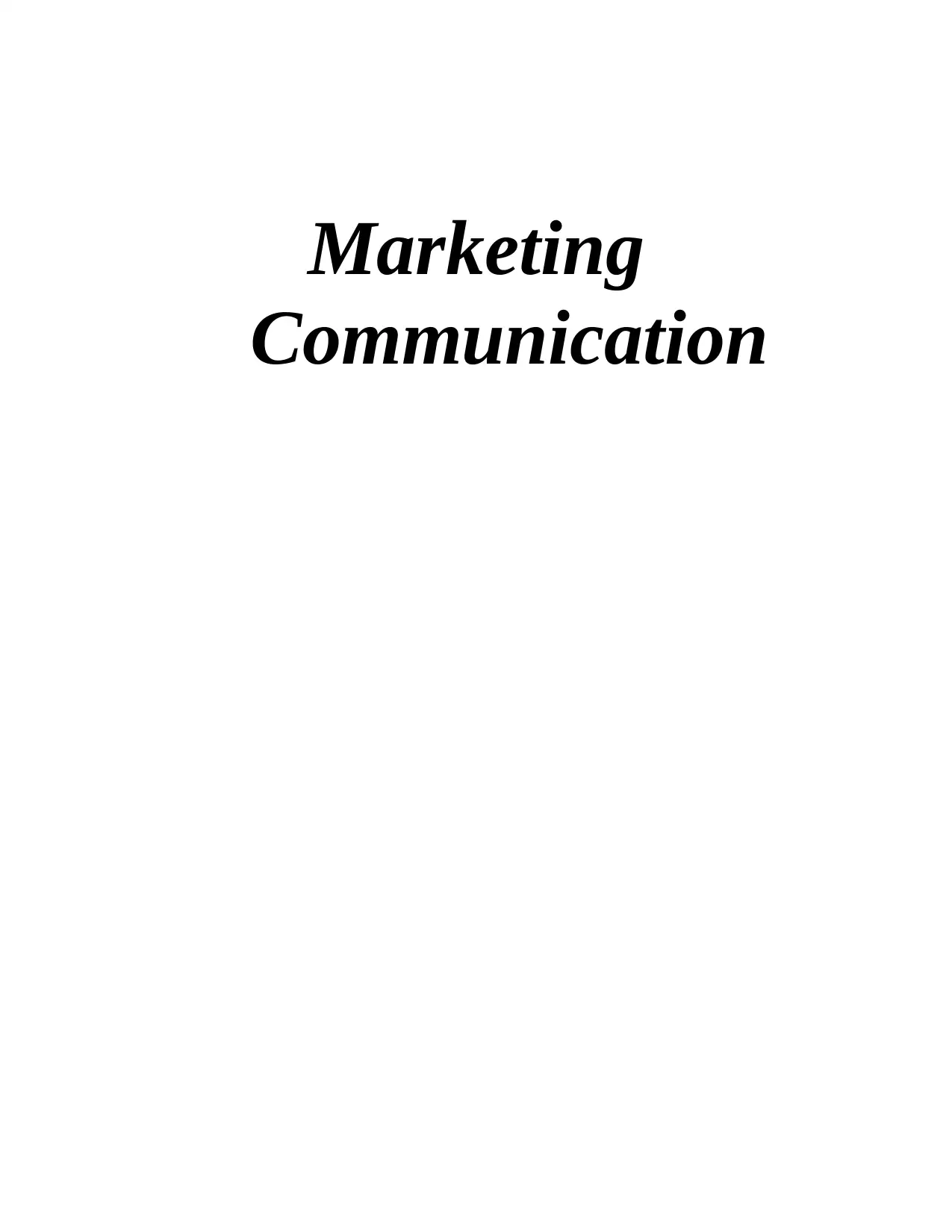
Marketing
Communication
Communication
Paraphrase This Document
Need a fresh take? Get an instant paraphrase of this document with our AI Paraphraser
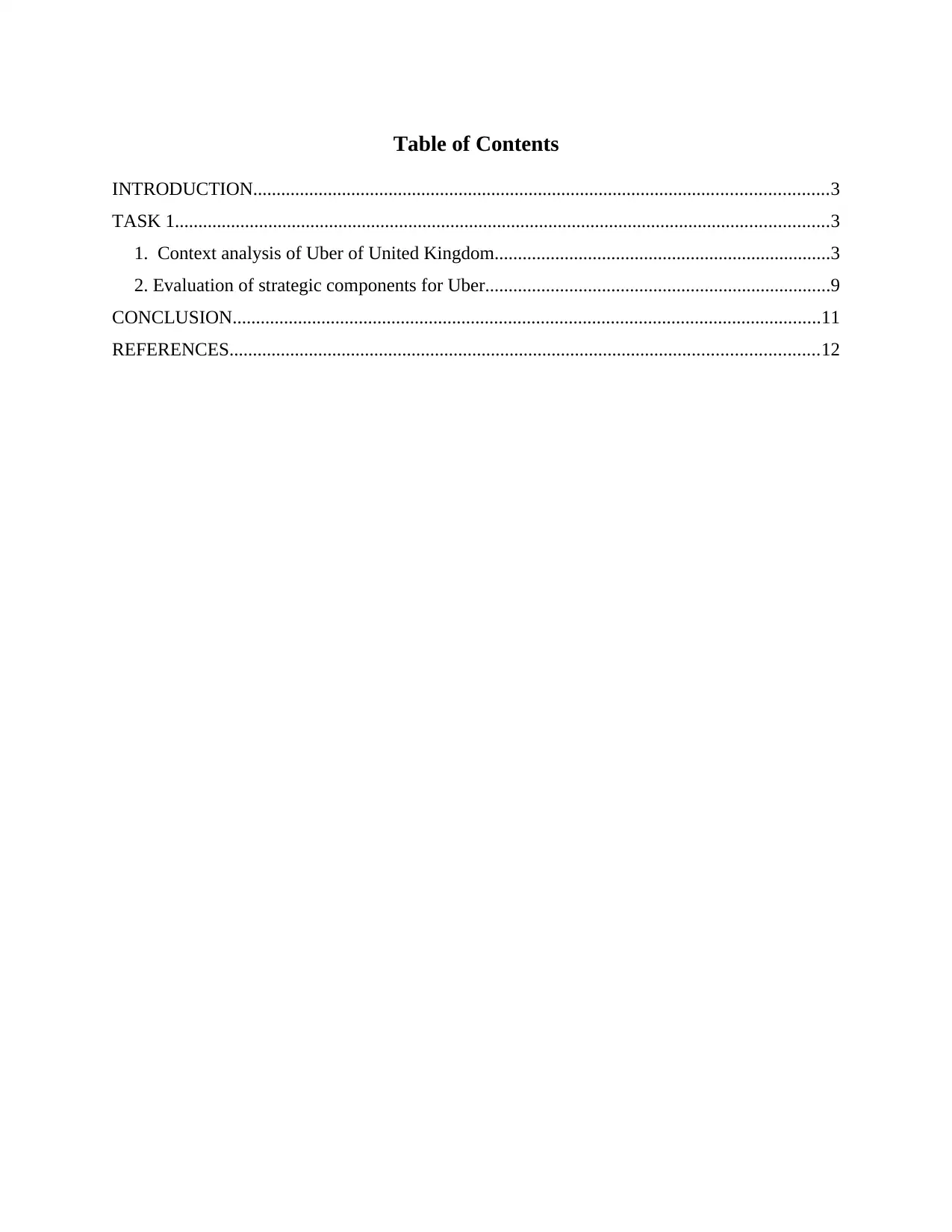
Table of Contents
INTRODUCTION...........................................................................................................................3
TASK 1............................................................................................................................................3
1. Context analysis of Uber of United Kingdom........................................................................3
2. Evaluation of strategic components for Uber..........................................................................9
CONCLUSION..............................................................................................................................11
REFERENCES..............................................................................................................................12
INTRODUCTION...........................................................................................................................3
TASK 1............................................................................................................................................3
1. Context analysis of Uber of United Kingdom........................................................................3
2. Evaluation of strategic components for Uber..........................................................................9
CONCLUSION..............................................................................................................................11
REFERENCES..............................................................................................................................12
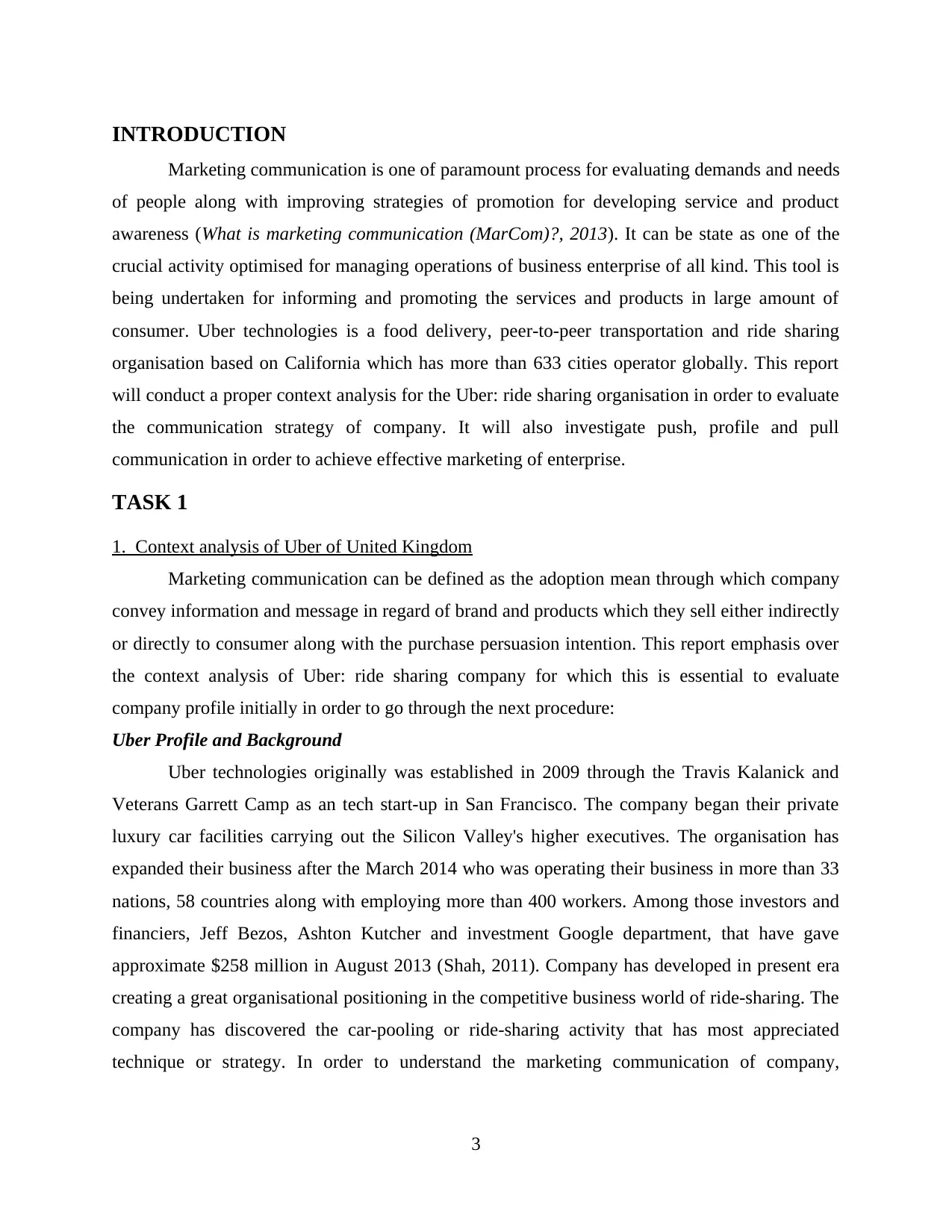
INTRODUCTION
Marketing communication is one of paramount process for evaluating demands and needs
of people along with improving strategies of promotion for developing service and product
awareness (What is marketing communication (MarCom)?, 2013). It can be state as one of the
crucial activity optimised for managing operations of business enterprise of all kind. This tool is
being undertaken for informing and promoting the services and products in large amount of
consumer. Uber technologies is a food delivery, peer-to-peer transportation and ride sharing
organisation based on California which has more than 633 cities operator globally. This report
will conduct a proper context analysis for the Uber: ride sharing organisation in order to evaluate
the communication strategy of company. It will also investigate push, profile and pull
communication in order to achieve effective marketing of enterprise.
TASK 1
1. Context analysis of Uber of United Kingdom
Marketing communication can be defined as the adoption mean through which company
convey information and message in regard of brand and products which they sell either indirectly
or directly to consumer along with the purchase persuasion intention. This report emphasis over
the context analysis of Uber: ride sharing company for which this is essential to evaluate
company profile initially in order to go through the next procedure:
Uber Profile and Background
Uber technologies originally was established in 2009 through the Travis Kalanick and
Veterans Garrett Camp as an tech start-up in San Francisco. The company began their private
luxury car facilities carrying out the Silicon Valley's higher executives. The organisation has
expanded their business after the March 2014 who was operating their business in more than 33
nations, 58 countries along with employing more than 400 workers. Among those investors and
financiers, Jeff Bezos, Ashton Kutcher and investment Google department, that have gave
approximate $258 million in August 2013 (Shah, 2011). Company has developed in present era
creating a great organisational positioning in the competitive business world of ride-sharing. The
company has discovered the car-pooling or ride-sharing activity that has most appreciated
technique or strategy. In order to understand the marketing communication of company,
3
Marketing communication is one of paramount process for evaluating demands and needs
of people along with improving strategies of promotion for developing service and product
awareness (What is marketing communication (MarCom)?, 2013). It can be state as one of the
crucial activity optimised for managing operations of business enterprise of all kind. This tool is
being undertaken for informing and promoting the services and products in large amount of
consumer. Uber technologies is a food delivery, peer-to-peer transportation and ride sharing
organisation based on California which has more than 633 cities operator globally. This report
will conduct a proper context analysis for the Uber: ride sharing organisation in order to evaluate
the communication strategy of company. It will also investigate push, profile and pull
communication in order to achieve effective marketing of enterprise.
TASK 1
1. Context analysis of Uber of United Kingdom
Marketing communication can be defined as the adoption mean through which company
convey information and message in regard of brand and products which they sell either indirectly
or directly to consumer along with the purchase persuasion intention. This report emphasis over
the context analysis of Uber: ride sharing company for which this is essential to evaluate
company profile initially in order to go through the next procedure:
Uber Profile and Background
Uber technologies originally was established in 2009 through the Travis Kalanick and
Veterans Garrett Camp as an tech start-up in San Francisco. The company began their private
luxury car facilities carrying out the Silicon Valley's higher executives. The organisation has
expanded their business after the March 2014 who was operating their business in more than 33
nations, 58 countries along with employing more than 400 workers. Among those investors and
financiers, Jeff Bezos, Ashton Kutcher and investment Google department, that have gave
approximate $258 million in August 2013 (Shah, 2011). Company has developed in present era
creating a great organisational positioning in the competitive business world of ride-sharing. The
company has discovered the car-pooling or ride-sharing activity that has most appreciated
technique or strategy. In order to understand the marketing communication of company,
3
⊘ This is a preview!⊘
Do you want full access?
Subscribe today to unlock all pages.

Trusted by 1+ million students worldwide
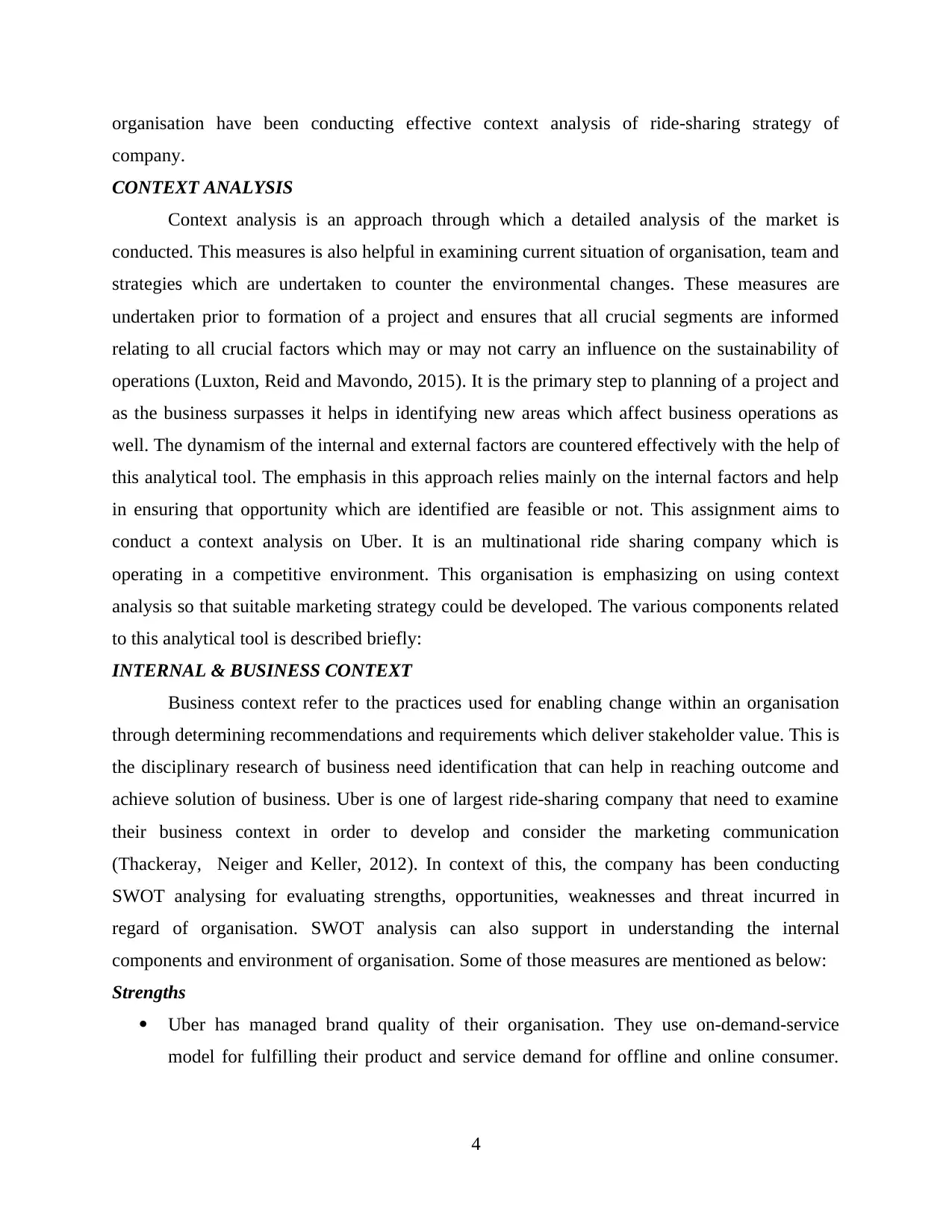
organisation have been conducting effective context analysis of ride-sharing strategy of
company.
CONTEXT ANALYSIS
Context analysis is an approach through which a detailed analysis of the market is
conducted. This measures is also helpful in examining current situation of organisation, team and
strategies which are undertaken to counter the environmental changes. These measures are
undertaken prior to formation of a project and ensures that all crucial segments are informed
relating to all crucial factors which may or may not carry an influence on the sustainability of
operations (Luxton, Reid and Mavondo, 2015). It is the primary step to planning of a project and
as the business surpasses it helps in identifying new areas which affect business operations as
well. The dynamism of the internal and external factors are countered effectively with the help of
this analytical tool. The emphasis in this approach relies mainly on the internal factors and help
in ensuring that opportunity which are identified are feasible or not. This assignment aims to
conduct a context analysis on Uber. It is an multinational ride sharing company which is
operating in a competitive environment. This organisation is emphasizing on using context
analysis so that suitable marketing strategy could be developed. The various components related
to this analytical tool is described briefly:
INTERNAL & BUSINESS CONTEXT
Business context refer to the practices used for enabling change within an organisation
through determining recommendations and requirements which deliver stakeholder value. This is
the disciplinary research of business need identification that can help in reaching outcome and
achieve solution of business. Uber is one of largest ride-sharing company that need to examine
their business context in order to develop and consider the marketing communication
(Thackeray, Neiger and Keller, 2012). In context of this, the company has been conducting
SWOT analysing for evaluating strengths, opportunities, weaknesses and threat incurred in
regard of organisation. SWOT analysis can also support in understanding the internal
components and environment of organisation. Some of those measures are mentioned as below:
Strengths
Uber has managed brand quality of their organisation. They use on-demand-service
model for fulfilling their product and service demand for offline and online consumer.
4
company.
CONTEXT ANALYSIS
Context analysis is an approach through which a detailed analysis of the market is
conducted. This measures is also helpful in examining current situation of organisation, team and
strategies which are undertaken to counter the environmental changes. These measures are
undertaken prior to formation of a project and ensures that all crucial segments are informed
relating to all crucial factors which may or may not carry an influence on the sustainability of
operations (Luxton, Reid and Mavondo, 2015). It is the primary step to planning of a project and
as the business surpasses it helps in identifying new areas which affect business operations as
well. The dynamism of the internal and external factors are countered effectively with the help of
this analytical tool. The emphasis in this approach relies mainly on the internal factors and help
in ensuring that opportunity which are identified are feasible or not. This assignment aims to
conduct a context analysis on Uber. It is an multinational ride sharing company which is
operating in a competitive environment. This organisation is emphasizing on using context
analysis so that suitable marketing strategy could be developed. The various components related
to this analytical tool is described briefly:
INTERNAL & BUSINESS CONTEXT
Business context refer to the practices used for enabling change within an organisation
through determining recommendations and requirements which deliver stakeholder value. This is
the disciplinary research of business need identification that can help in reaching outcome and
achieve solution of business. Uber is one of largest ride-sharing company that need to examine
their business context in order to develop and consider the marketing communication
(Thackeray, Neiger and Keller, 2012). In context of this, the company has been conducting
SWOT analysing for evaluating strengths, opportunities, weaknesses and threat incurred in
regard of organisation. SWOT analysis can also support in understanding the internal
components and environment of organisation. Some of those measures are mentioned as below:
Strengths
Uber has managed brand quality of their organisation. They use on-demand-service
model for fulfilling their product and service demand for offline and online consumer.
4
Paraphrase This Document
Need a fresh take? Get an instant paraphrase of this document with our AI Paraphraser
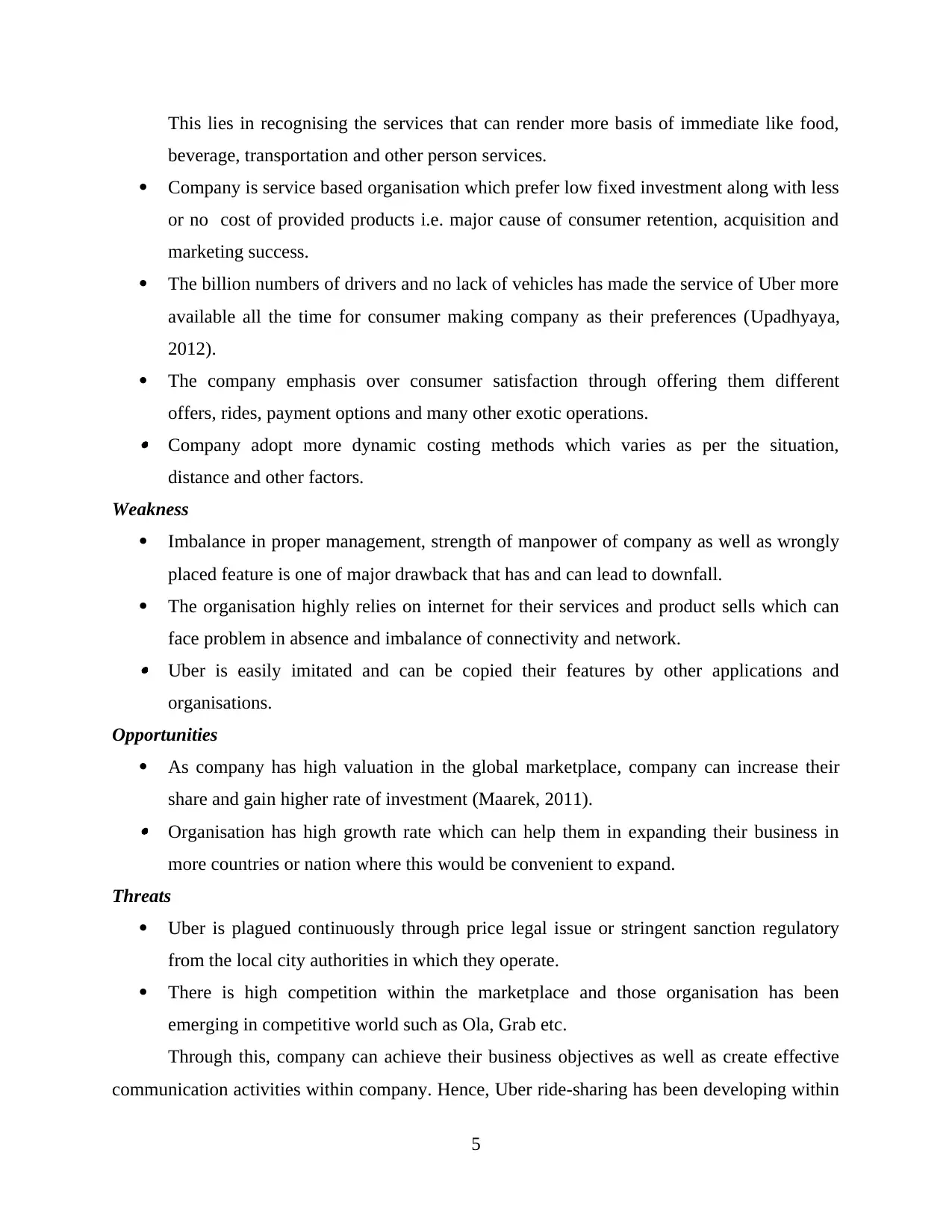
This lies in recognising the services that can render more basis of immediate like food,
beverage, transportation and other person services.
Company is service based organisation which prefer low fixed investment along with less
or no cost of provided products i.e. major cause of consumer retention, acquisition and
marketing success.
The billion numbers of drivers and no lack of vehicles has made the service of Uber more
available all the time for consumer making company as their preferences (Upadhyaya,
2012).
The company emphasis over consumer satisfaction through offering them different
offers, rides, payment options and many other exotic operations. Company adopt more dynamic costing methods which varies as per the situation,
distance and other factors.
Weakness
Imbalance in proper management, strength of manpower of company as well as wrongly
placed feature is one of major drawback that has and can lead to downfall.
The organisation highly relies on internet for their services and product sells which can
face problem in absence and imbalance of connectivity and network. Uber is easily imitated and can be copied their features by other applications and
organisations.
Opportunities
As company has high valuation in the global marketplace, company can increase their
share and gain higher rate of investment (Maarek, 2011). Organisation has high growth rate which can help them in expanding their business in
more countries or nation where this would be convenient to expand.
Threats
Uber is plagued continuously through price legal issue or stringent sanction regulatory
from the local city authorities in which they operate.
There is high competition within the marketplace and those organisation has been
emerging in competitive world such as Ola, Grab etc.
Through this, company can achieve their business objectives as well as create effective
communication activities within company. Hence, Uber ride-sharing has been developing within
5
beverage, transportation and other person services.
Company is service based organisation which prefer low fixed investment along with less
or no cost of provided products i.e. major cause of consumer retention, acquisition and
marketing success.
The billion numbers of drivers and no lack of vehicles has made the service of Uber more
available all the time for consumer making company as their preferences (Upadhyaya,
2012).
The company emphasis over consumer satisfaction through offering them different
offers, rides, payment options and many other exotic operations. Company adopt more dynamic costing methods which varies as per the situation,
distance and other factors.
Weakness
Imbalance in proper management, strength of manpower of company as well as wrongly
placed feature is one of major drawback that has and can lead to downfall.
The organisation highly relies on internet for their services and product sells which can
face problem in absence and imbalance of connectivity and network. Uber is easily imitated and can be copied their features by other applications and
organisations.
Opportunities
As company has high valuation in the global marketplace, company can increase their
share and gain higher rate of investment (Maarek, 2011). Organisation has high growth rate which can help them in expanding their business in
more countries or nation where this would be convenient to expand.
Threats
Uber is plagued continuously through price legal issue or stringent sanction regulatory
from the local city authorities in which they operate.
There is high competition within the marketplace and those organisation has been
emerging in competitive world such as Ola, Grab etc.
Through this, company can achieve their business objectives as well as create effective
communication activities within company. Hence, Uber ride-sharing has been developing within
5
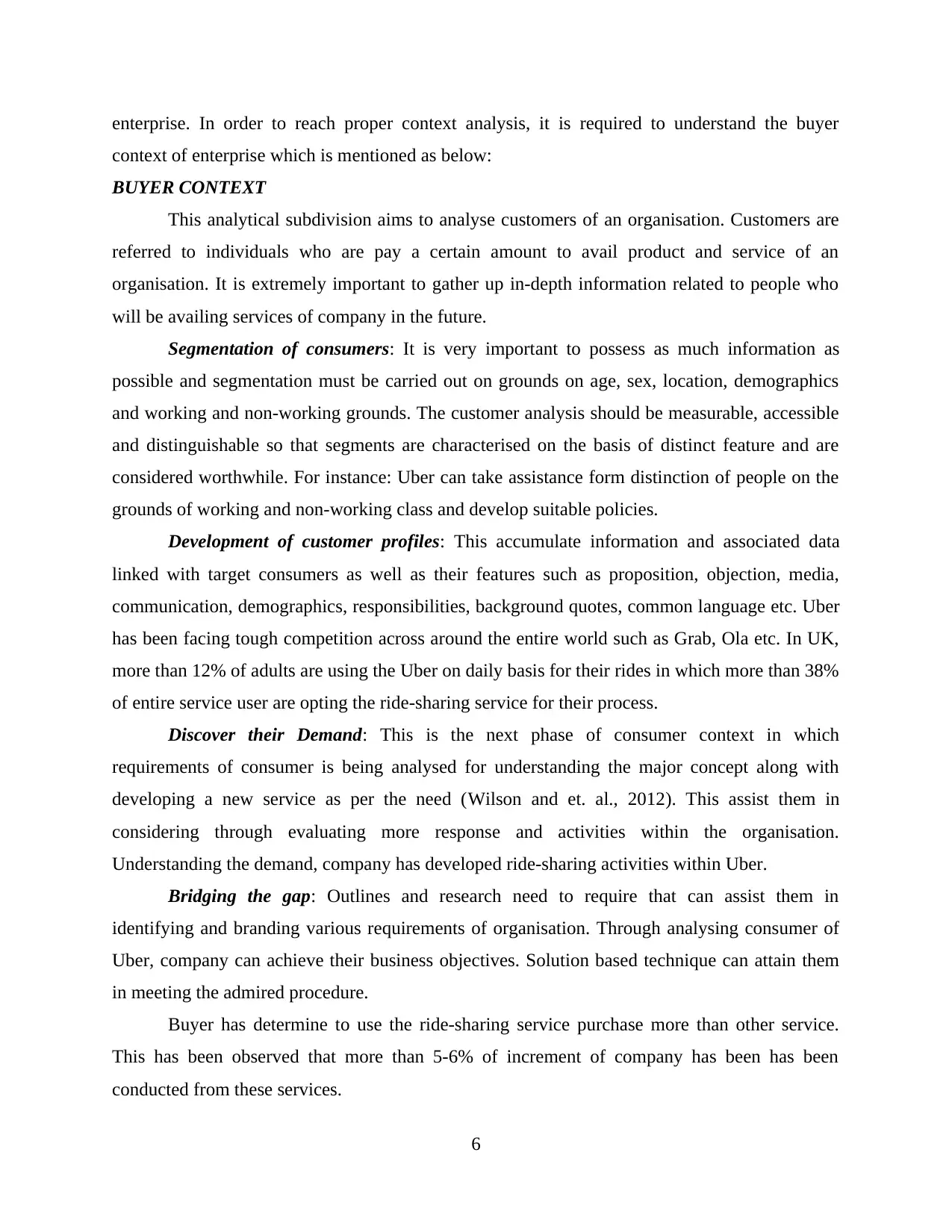
enterprise. In order to reach proper context analysis, it is required to understand the buyer
context of enterprise which is mentioned as below:
BUYER CONTEXT
This analytical subdivision aims to analyse customers of an organisation. Customers are
referred to individuals who are pay a certain amount to avail product and service of an
organisation. It is extremely important to gather up in-depth information related to people who
will be availing services of company in the future.
Segmentation of consumers: It is very important to possess as much information as
possible and segmentation must be carried out on grounds on age, sex, location, demographics
and working and non-working grounds. The customer analysis should be measurable, accessible
and distinguishable so that segments are characterised on the basis of distinct feature and are
considered worthwhile. For instance: Uber can take assistance form distinction of people on the
grounds of working and non-working class and develop suitable policies.
Development of customer profiles: This accumulate information and associated data
linked with target consumers as well as their features such as proposition, objection, media,
communication, demographics, responsibilities, background quotes, common language etc. Uber
has been facing tough competition across around the entire world such as Grab, Ola etc. In UK,
more than 12% of adults are using the Uber on daily basis for their rides in which more than 38%
of entire service user are opting the ride-sharing service for their process.
Discover their Demand: This is the next phase of consumer context in which
requirements of consumer is being analysed for understanding the major concept along with
developing a new service as per the need (Wilson and et. al., 2012). This assist them in
considering through evaluating more response and activities within the organisation.
Understanding the demand, company has developed ride-sharing activities within Uber.
Bridging the gap: Outlines and research need to require that can assist them in
identifying and branding various requirements of organisation. Through analysing consumer of
Uber, company can achieve their business objectives. Solution based technique can attain them
in meeting the admired procedure.
Buyer has determine to use the ride-sharing service purchase more than other service.
This has been observed that more than 5-6% of increment of company has been has been
conducted from these services.
6
context of enterprise which is mentioned as below:
BUYER CONTEXT
This analytical subdivision aims to analyse customers of an organisation. Customers are
referred to individuals who are pay a certain amount to avail product and service of an
organisation. It is extremely important to gather up in-depth information related to people who
will be availing services of company in the future.
Segmentation of consumers: It is very important to possess as much information as
possible and segmentation must be carried out on grounds on age, sex, location, demographics
and working and non-working grounds. The customer analysis should be measurable, accessible
and distinguishable so that segments are characterised on the basis of distinct feature and are
considered worthwhile. For instance: Uber can take assistance form distinction of people on the
grounds of working and non-working class and develop suitable policies.
Development of customer profiles: This accumulate information and associated data
linked with target consumers as well as their features such as proposition, objection, media,
communication, demographics, responsibilities, background quotes, common language etc. Uber
has been facing tough competition across around the entire world such as Grab, Ola etc. In UK,
more than 12% of adults are using the Uber on daily basis for their rides in which more than 38%
of entire service user are opting the ride-sharing service for their process.
Discover their Demand: This is the next phase of consumer context in which
requirements of consumer is being analysed for understanding the major concept along with
developing a new service as per the need (Wilson and et. al., 2012). This assist them in
considering through evaluating more response and activities within the organisation.
Understanding the demand, company has developed ride-sharing activities within Uber.
Bridging the gap: Outlines and research need to require that can assist them in
identifying and branding various requirements of organisation. Through analysing consumer of
Uber, company can achieve their business objectives. Solution based technique can attain them
in meeting the admired procedure.
Buyer has determine to use the ride-sharing service purchase more than other service.
This has been observed that more than 5-6% of increment of company has been has been
conducted from these services.
6
⊘ This is a preview!⊘
Do you want full access?
Subscribe today to unlock all pages.

Trusted by 1+ million students worldwide
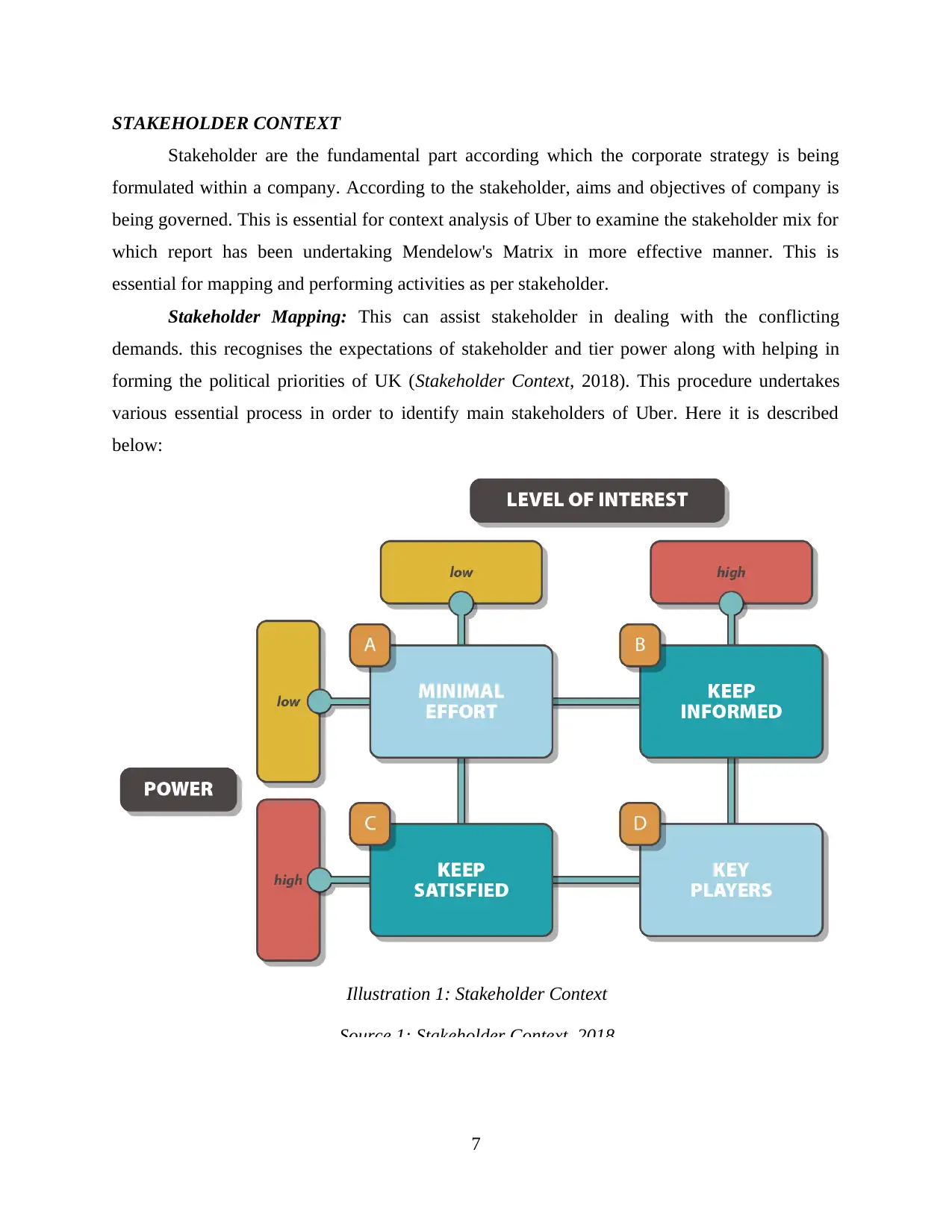
STAKEHOLDER CONTEXT
Stakeholder are the fundamental part according which the corporate strategy is being
formulated within a company. According to the stakeholder, aims and objectives of company is
being governed. This is essential for context analysis of Uber to examine the stakeholder mix for
which report has been undertaking Mendelow's Matrix in more effective manner. This is
essential for mapping and performing activities as per stakeholder.
Stakeholder Mapping: This can assist stakeholder in dealing with the conflicting
demands. this recognises the expectations of stakeholder and tier power along with helping in
forming the political priorities of UK (Stakeholder Context, 2018). This procedure undertakes
various essential process in order to identify main stakeholders of Uber. Here it is described
below:
7
Illustration 1: Stakeholder Context
Source 1: Stakeholder Context, 2018
Stakeholder are the fundamental part according which the corporate strategy is being
formulated within a company. According to the stakeholder, aims and objectives of company is
being governed. This is essential for context analysis of Uber to examine the stakeholder mix for
which report has been undertaking Mendelow's Matrix in more effective manner. This is
essential for mapping and performing activities as per stakeholder.
Stakeholder Mapping: This can assist stakeholder in dealing with the conflicting
demands. this recognises the expectations of stakeholder and tier power along with helping in
forming the political priorities of UK (Stakeholder Context, 2018). This procedure undertakes
various essential process in order to identify main stakeholders of Uber. Here it is described
below:
7
Illustration 1: Stakeholder Context
Source 1: Stakeholder Context, 2018
Paraphrase This Document
Need a fresh take? Get an instant paraphrase of this document with our AI Paraphraser
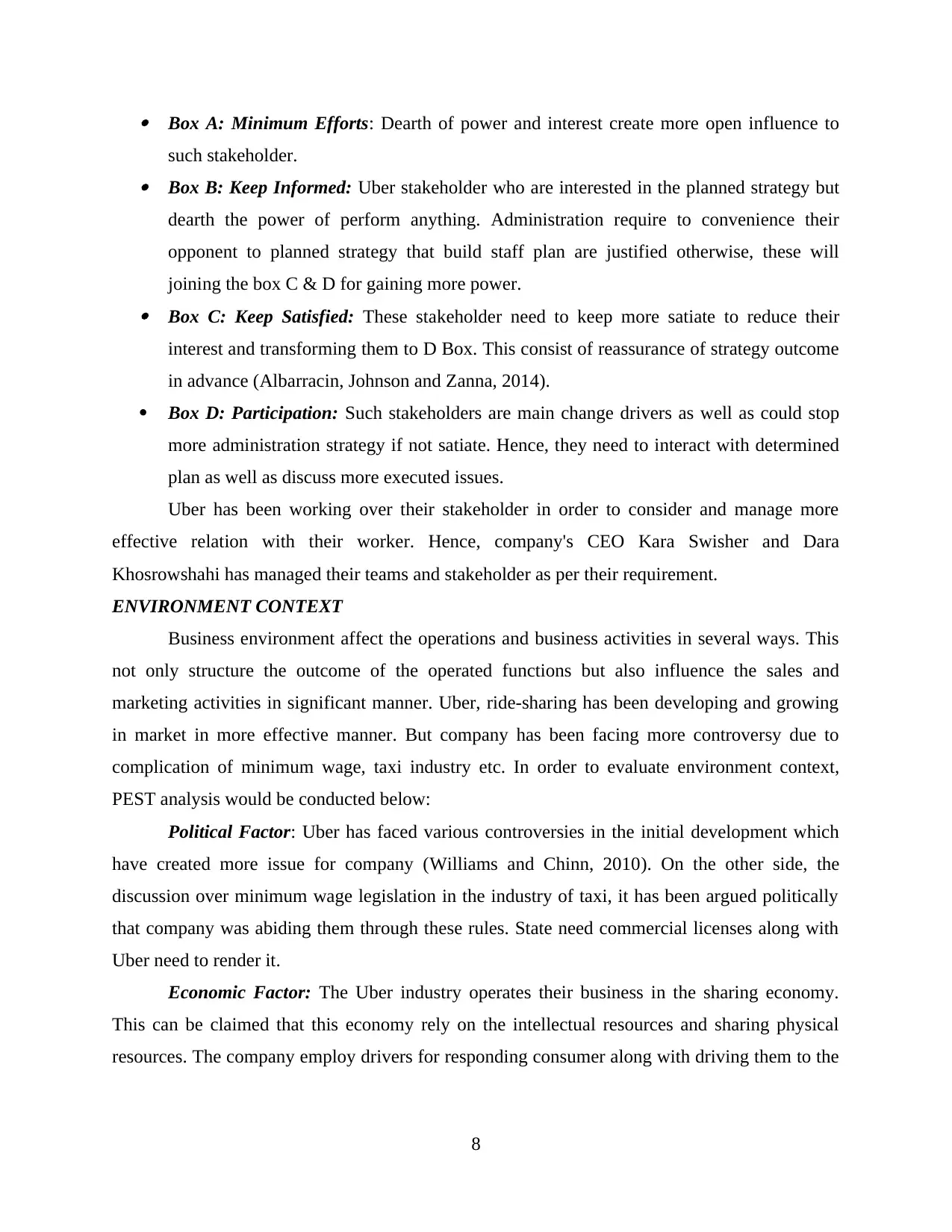
Box A: Minimum Efforts: Dearth of power and interest create more open influence to
such stakeholder. Box B: Keep Informed: Uber stakeholder who are interested in the planned strategy but
dearth the power of perform anything. Administration require to convenience their
opponent to planned strategy that build staff plan are justified otherwise, these will
joining the box C & D for gaining more power. Box C: Keep Satisfied: These stakeholder need to keep more satiate to reduce their
interest and transforming them to D Box. This consist of reassurance of strategy outcome
in advance (Albarracin, Johnson and Zanna, 2014).
Box D: Participation: Such stakeholders are main change drivers as well as could stop
more administration strategy if not satiate. Hence, they need to interact with determined
plan as well as discuss more executed issues.
Uber has been working over their stakeholder in order to consider and manage more
effective relation with their worker. Hence, company's CEO Kara Swisher and Dara
Khosrowshahi has managed their teams and stakeholder as per their requirement.
ENVIRONMENT CONTEXT
Business environment affect the operations and business activities in several ways. This
not only structure the outcome of the operated functions but also influence the sales and
marketing activities in significant manner. Uber, ride-sharing has been developing and growing
in market in more effective manner. But company has been facing more controversy due to
complication of minimum wage, taxi industry etc. In order to evaluate environment context,
PEST analysis would be conducted below:
Political Factor: Uber has faced various controversies in the initial development which
have created more issue for company (Williams and Chinn, 2010). On the other side, the
discussion over minimum wage legislation in the industry of taxi, it has been argued politically
that company was abiding them through these rules. State need commercial licenses along with
Uber need to render it.
Economic Factor: The Uber industry operates their business in the sharing economy.
This can be claimed that this economy rely on the intellectual resources and sharing physical
resources. The company employ drivers for responding consumer along with driving them to the
8
such stakeholder. Box B: Keep Informed: Uber stakeholder who are interested in the planned strategy but
dearth the power of perform anything. Administration require to convenience their
opponent to planned strategy that build staff plan are justified otherwise, these will
joining the box C & D for gaining more power. Box C: Keep Satisfied: These stakeholder need to keep more satiate to reduce their
interest and transforming them to D Box. This consist of reassurance of strategy outcome
in advance (Albarracin, Johnson and Zanna, 2014).
Box D: Participation: Such stakeholders are main change drivers as well as could stop
more administration strategy if not satiate. Hence, they need to interact with determined
plan as well as discuss more executed issues.
Uber has been working over their stakeholder in order to consider and manage more
effective relation with their worker. Hence, company's CEO Kara Swisher and Dara
Khosrowshahi has managed their teams and stakeholder as per their requirement.
ENVIRONMENT CONTEXT
Business environment affect the operations and business activities in several ways. This
not only structure the outcome of the operated functions but also influence the sales and
marketing activities in significant manner. Uber, ride-sharing has been developing and growing
in market in more effective manner. But company has been facing more controversy due to
complication of minimum wage, taxi industry etc. In order to evaluate environment context,
PEST analysis would be conducted below:
Political Factor: Uber has faced various controversies in the initial development which
have created more issue for company (Williams and Chinn, 2010). On the other side, the
discussion over minimum wage legislation in the industry of taxi, it has been argued politically
that company was abiding them through these rules. State need commercial licenses along with
Uber need to render it.
Economic Factor: The Uber industry operates their business in the sharing economy.
This can be claimed that this economy rely on the intellectual resources and sharing physical
resources. The company employ drivers for responding consumer along with driving them to the
8
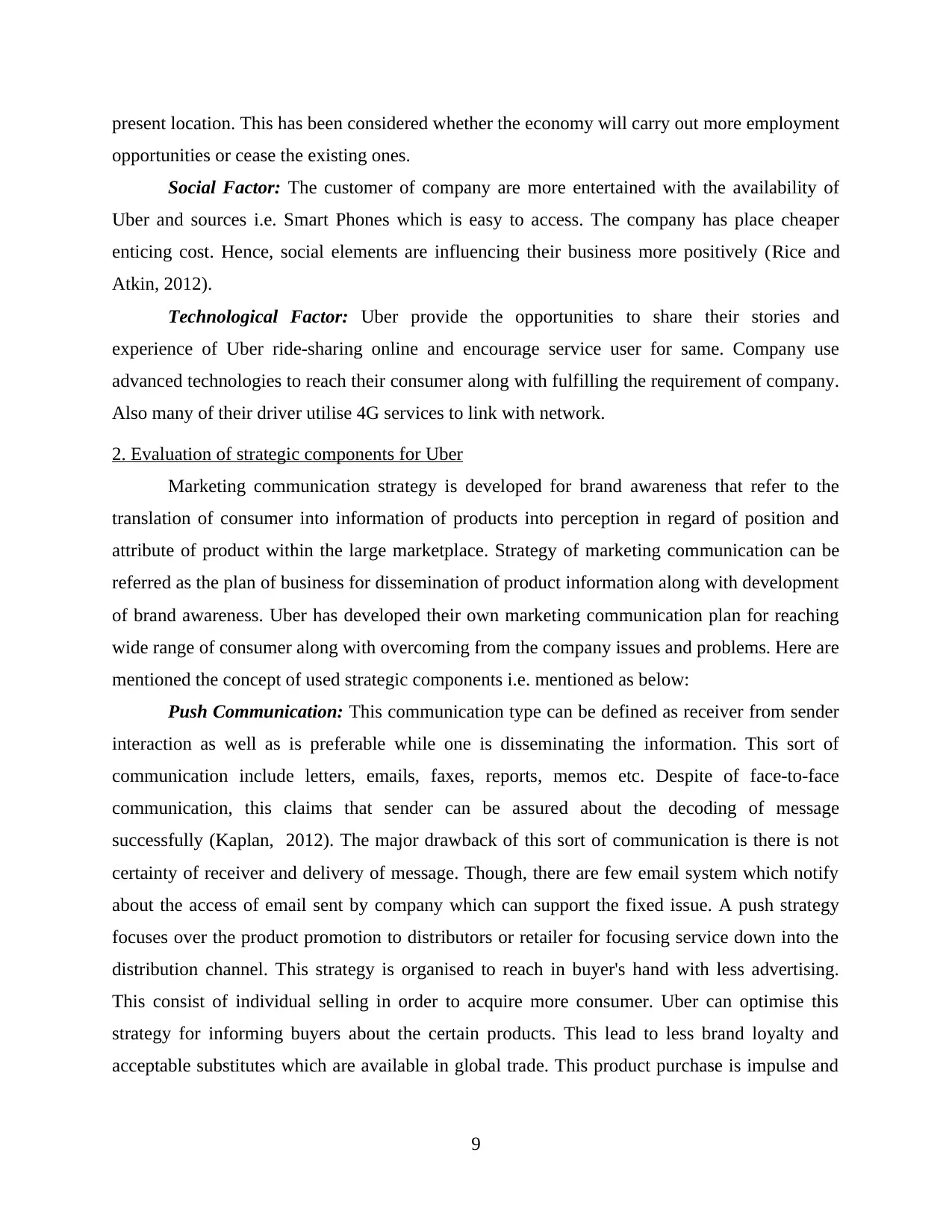
present location. This has been considered whether the economy will carry out more employment
opportunities or cease the existing ones.
Social Factor: The customer of company are more entertained with the availability of
Uber and sources i.e. Smart Phones which is easy to access. The company has place cheaper
enticing cost. Hence, social elements are influencing their business more positively (Rice and
Atkin, 2012).
Technological Factor: Uber provide the opportunities to share their stories and
experience of Uber ride-sharing online and encourage service user for same. Company use
advanced technologies to reach their consumer along with fulfilling the requirement of company.
Also many of their driver utilise 4G services to link with network.
2. Evaluation of strategic components for Uber
Marketing communication strategy is developed for brand awareness that refer to the
translation of consumer into information of products into perception in regard of position and
attribute of product within the large marketplace. Strategy of marketing communication can be
referred as the plan of business for dissemination of product information along with development
of brand awareness. Uber has developed their own marketing communication plan for reaching
wide range of consumer along with overcoming from the company issues and problems. Here are
mentioned the concept of used strategic components i.e. mentioned as below:
Push Communication: This communication type can be defined as receiver from sender
interaction as well as is preferable while one is disseminating the information. This sort of
communication include letters, emails, faxes, reports, memos etc. Despite of face-to-face
communication, this claims that sender can be assured about the decoding of message
successfully (Kaplan, 2012). The major drawback of this sort of communication is there is not
certainty of receiver and delivery of message. Though, there are few email system which notify
about the access of email sent by company which can support the fixed issue. A push strategy
focuses over the product promotion to distributors or retailer for focusing service down into the
distribution channel. This strategy is organised to reach in buyer's hand with less advertising.
This consist of individual selling in order to acquire more consumer. Uber can optimise this
strategy for informing buyers about the certain products. This lead to less brand loyalty and
acceptable substitutes which are available in global trade. This product purchase is impulse and
9
opportunities or cease the existing ones.
Social Factor: The customer of company are more entertained with the availability of
Uber and sources i.e. Smart Phones which is easy to access. The company has place cheaper
enticing cost. Hence, social elements are influencing their business more positively (Rice and
Atkin, 2012).
Technological Factor: Uber provide the opportunities to share their stories and
experience of Uber ride-sharing online and encourage service user for same. Company use
advanced technologies to reach their consumer along with fulfilling the requirement of company.
Also many of their driver utilise 4G services to link with network.
2. Evaluation of strategic components for Uber
Marketing communication strategy is developed for brand awareness that refer to the
translation of consumer into information of products into perception in regard of position and
attribute of product within the large marketplace. Strategy of marketing communication can be
referred as the plan of business for dissemination of product information along with development
of brand awareness. Uber has developed their own marketing communication plan for reaching
wide range of consumer along with overcoming from the company issues and problems. Here are
mentioned the concept of used strategic components i.e. mentioned as below:
Push Communication: This communication type can be defined as receiver from sender
interaction as well as is preferable while one is disseminating the information. This sort of
communication include letters, emails, faxes, reports, memos etc. Despite of face-to-face
communication, this claims that sender can be assured about the decoding of message
successfully (Kaplan, 2012). The major drawback of this sort of communication is there is not
certainty of receiver and delivery of message. Though, there are few email system which notify
about the access of email sent by company which can support the fixed issue. A push strategy
focuses over the product promotion to distributors or retailer for focusing service down into the
distribution channel. This strategy is organised to reach in buyer's hand with less advertising.
This consist of individual selling in order to acquire more consumer. Uber can optimise this
strategy for informing buyers about the certain products. This lead to less brand loyalty and
acceptable substitutes which are available in global trade. This product purchase is impulse and
9
⊘ This is a preview!⊘
Do you want full access?
Subscribe today to unlock all pages.

Trusted by 1+ million students worldwide
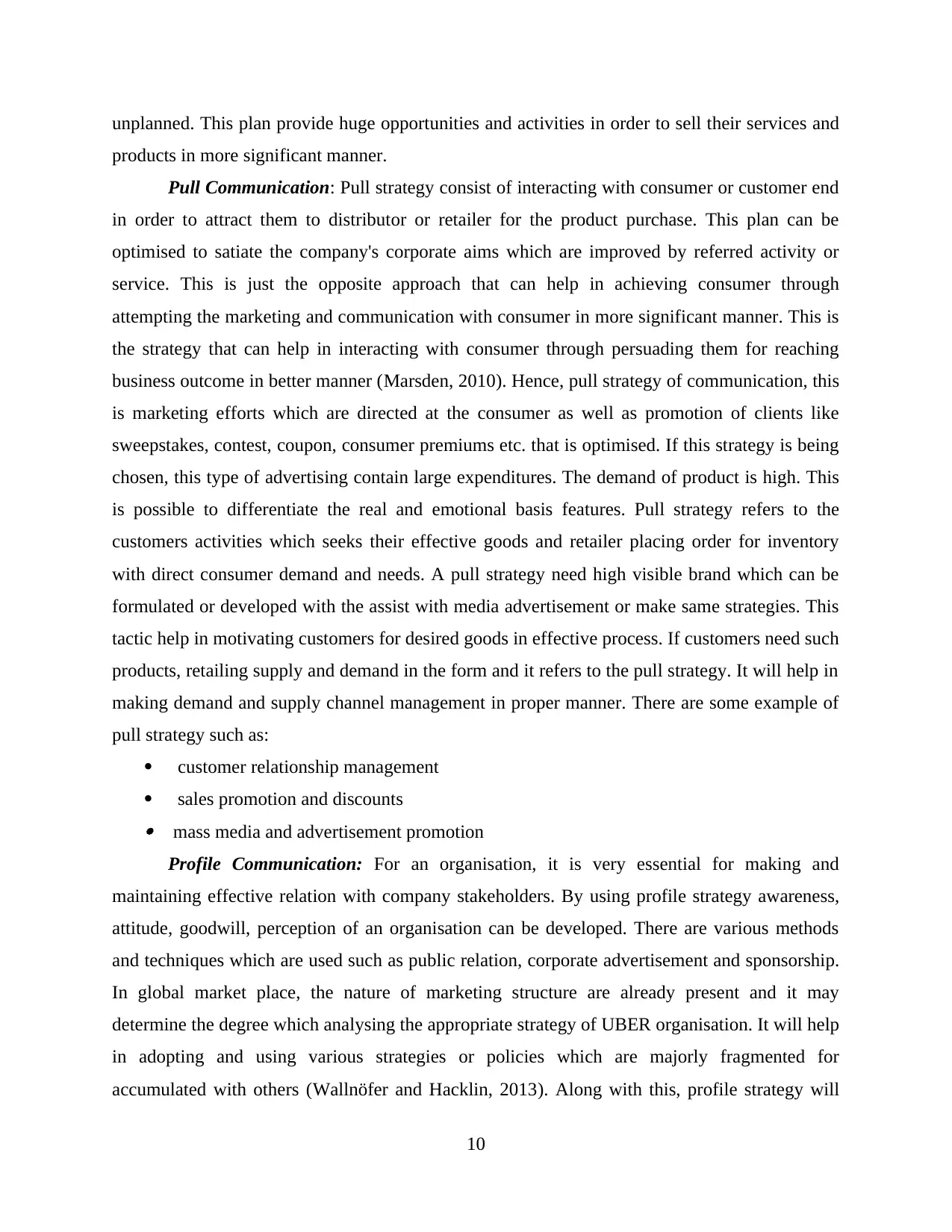
unplanned. This plan provide huge opportunities and activities in order to sell their services and
products in more significant manner.
Pull Communication: Pull strategy consist of interacting with consumer or customer end
in order to attract them to distributor or retailer for the product purchase. This plan can be
optimised to satiate the company's corporate aims which are improved by referred activity or
service. This is just the opposite approach that can help in achieving consumer through
attempting the marketing and communication with consumer in more significant manner. This is
the strategy that can help in interacting with consumer through persuading them for reaching
business outcome in better manner (Marsden, 2010). Hence, pull strategy of communication, this
is marketing efforts which are directed at the consumer as well as promotion of clients like
sweepstakes, contest, coupon, consumer premiums etc. that is optimised. If this strategy is being
chosen, this type of advertising contain large expenditures. The demand of product is high. This
is possible to differentiate the real and emotional basis features. Pull strategy refers to the
customers activities which seeks their effective goods and retailer placing order for inventory
with direct consumer demand and needs. A pull strategy need high visible brand which can be
formulated or developed with the assist with media advertisement or make same strategies. This
tactic help in motivating customers for desired goods in effective process. If customers need such
products, retailing supply and demand in the form and it refers to the pull strategy. It will help in
making demand and supply channel management in proper manner. There are some example of
pull strategy such as:
customer relationship management
sales promotion and discounts mass media and advertisement promotion
Profile Communication: For an organisation, it is very essential for making and
maintaining effective relation with company stakeholders. By using profile strategy awareness,
attitude, goodwill, perception of an organisation can be developed. There are various methods
and techniques which are used such as public relation, corporate advertisement and sponsorship.
In global market place, the nature of marketing structure are already present and it may
determine the degree which analysing the appropriate strategy of UBER organisation. It will help
in adopting and using various strategies or policies which are majorly fragmented for
accumulated with others (Wallnöfer and Hacklin, 2013). Along with this, profile strategy will
10
products in more significant manner.
Pull Communication: Pull strategy consist of interacting with consumer or customer end
in order to attract them to distributor or retailer for the product purchase. This plan can be
optimised to satiate the company's corporate aims which are improved by referred activity or
service. This is just the opposite approach that can help in achieving consumer through
attempting the marketing and communication with consumer in more significant manner. This is
the strategy that can help in interacting with consumer through persuading them for reaching
business outcome in better manner (Marsden, 2010). Hence, pull strategy of communication, this
is marketing efforts which are directed at the consumer as well as promotion of clients like
sweepstakes, contest, coupon, consumer premiums etc. that is optimised. If this strategy is being
chosen, this type of advertising contain large expenditures. The demand of product is high. This
is possible to differentiate the real and emotional basis features. Pull strategy refers to the
customers activities which seeks their effective goods and retailer placing order for inventory
with direct consumer demand and needs. A pull strategy need high visible brand which can be
formulated or developed with the assist with media advertisement or make same strategies. This
tactic help in motivating customers for desired goods in effective process. If customers need such
products, retailing supply and demand in the form and it refers to the pull strategy. It will help in
making demand and supply channel management in proper manner. There are some example of
pull strategy such as:
customer relationship management
sales promotion and discounts mass media and advertisement promotion
Profile Communication: For an organisation, it is very essential for making and
maintaining effective relation with company stakeholders. By using profile strategy awareness,
attitude, goodwill, perception of an organisation can be developed. There are various methods
and techniques which are used such as public relation, corporate advertisement and sponsorship.
In global market place, the nature of marketing structure are already present and it may
determine the degree which analysing the appropriate strategy of UBER organisation. It will help
in adopting and using various strategies or policies which are majorly fragmented for
accumulated with others (Wallnöfer and Hacklin, 2013). Along with this, profile strategy will
10
Paraphrase This Document
Need a fresh take? Get an instant paraphrase of this document with our AI Paraphraser
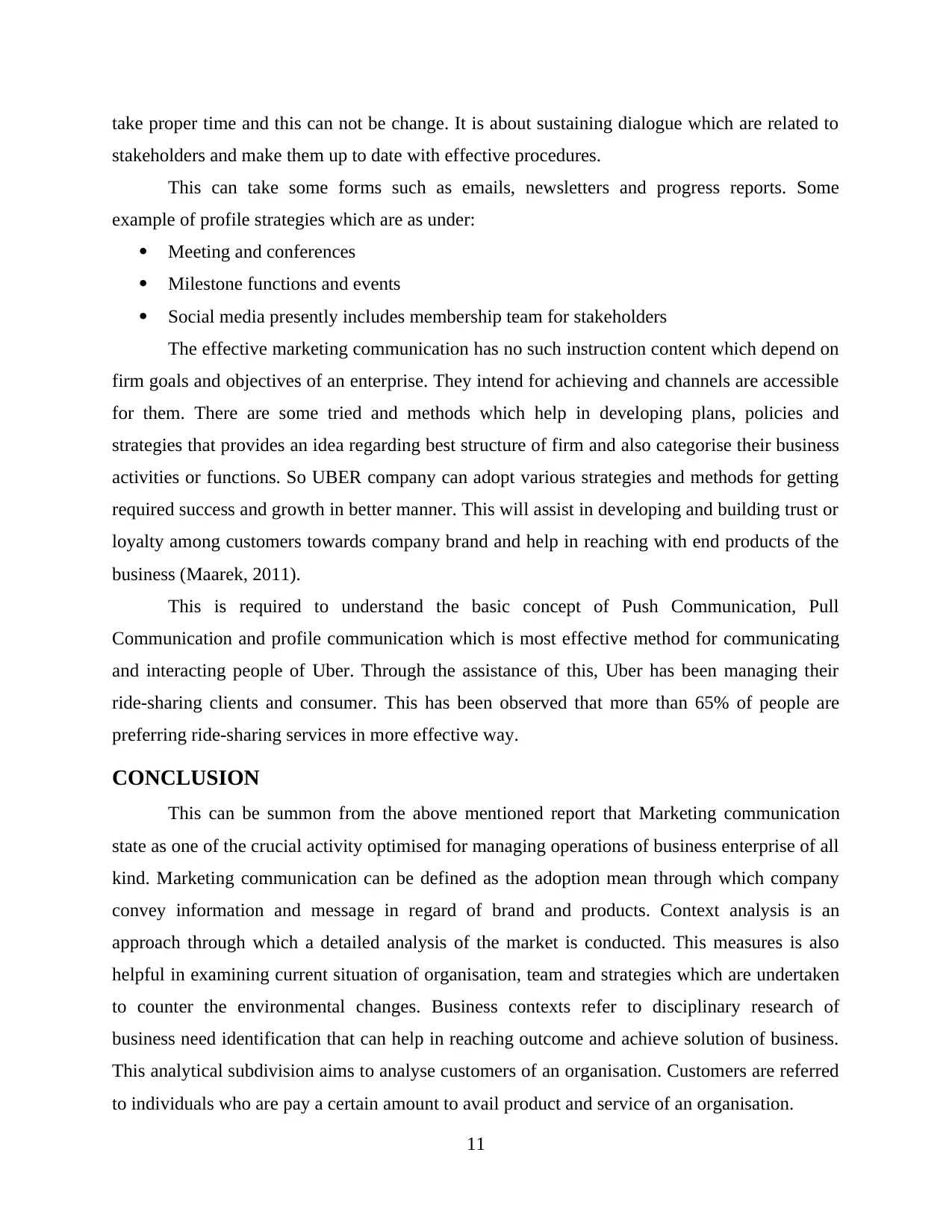
take proper time and this can not be change. It is about sustaining dialogue which are related to
stakeholders and make them up to date with effective procedures.
This can take some forms such as emails, newsletters and progress reports. Some
example of profile strategies which are as under:
Meeting and conferences
Milestone functions and events
Social media presently includes membership team for stakeholders
The effective marketing communication has no such instruction content which depend on
firm goals and objectives of an enterprise. They intend for achieving and channels are accessible
for them. There are some tried and methods which help in developing plans, policies and
strategies that provides an idea regarding best structure of firm and also categorise their business
activities or functions. So UBER company can adopt various strategies and methods for getting
required success and growth in better manner. This will assist in developing and building trust or
loyalty among customers towards company brand and help in reaching with end products of the
business (Maarek, 2011).
This is required to understand the basic concept of Push Communication, Pull
Communication and profile communication which is most effective method for communicating
and interacting people of Uber. Through the assistance of this, Uber has been managing their
ride-sharing clients and consumer. This has been observed that more than 65% of people are
preferring ride-sharing services in more effective way.
CONCLUSION
This can be summon from the above mentioned report that Marketing communication
state as one of the crucial activity optimised for managing operations of business enterprise of all
kind. Marketing communication can be defined as the adoption mean through which company
convey information and message in regard of brand and products. Context analysis is an
approach through which a detailed analysis of the market is conducted. This measures is also
helpful in examining current situation of organisation, team and strategies which are undertaken
to counter the environmental changes. Business contexts refer to disciplinary research of
business need identification that can help in reaching outcome and achieve solution of business.
This analytical subdivision aims to analyse customers of an organisation. Customers are referred
to individuals who are pay a certain amount to avail product and service of an organisation.
11
stakeholders and make them up to date with effective procedures.
This can take some forms such as emails, newsletters and progress reports. Some
example of profile strategies which are as under:
Meeting and conferences
Milestone functions and events
Social media presently includes membership team for stakeholders
The effective marketing communication has no such instruction content which depend on
firm goals and objectives of an enterprise. They intend for achieving and channels are accessible
for them. There are some tried and methods which help in developing plans, policies and
strategies that provides an idea regarding best structure of firm and also categorise their business
activities or functions. So UBER company can adopt various strategies and methods for getting
required success and growth in better manner. This will assist in developing and building trust or
loyalty among customers towards company brand and help in reaching with end products of the
business (Maarek, 2011).
This is required to understand the basic concept of Push Communication, Pull
Communication and profile communication which is most effective method for communicating
and interacting people of Uber. Through the assistance of this, Uber has been managing their
ride-sharing clients and consumer. This has been observed that more than 65% of people are
preferring ride-sharing services in more effective way.
CONCLUSION
This can be summon from the above mentioned report that Marketing communication
state as one of the crucial activity optimised for managing operations of business enterprise of all
kind. Marketing communication can be defined as the adoption mean through which company
convey information and message in regard of brand and products. Context analysis is an
approach through which a detailed analysis of the market is conducted. This measures is also
helpful in examining current situation of organisation, team and strategies which are undertaken
to counter the environmental changes. Business contexts refer to disciplinary research of
business need identification that can help in reaching outcome and achieve solution of business.
This analytical subdivision aims to analyse customers of an organisation. Customers are referred
to individuals who are pay a certain amount to avail product and service of an organisation.
11
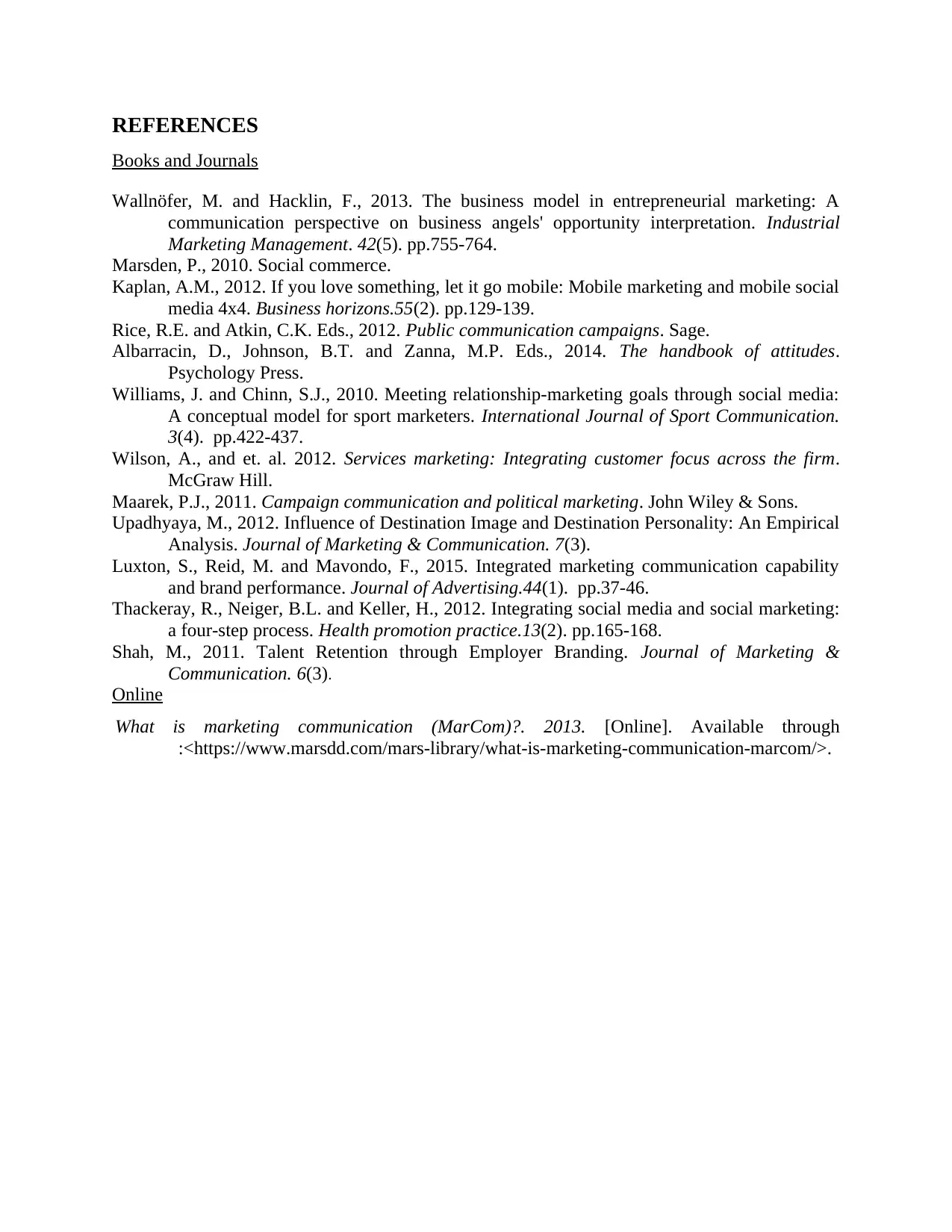
REFERENCES
Books and Journals
Wallnöfer, M. and Hacklin, F., 2013. The business model in entrepreneurial marketing: A
communication perspective on business angels' opportunity interpretation. Industrial
Marketing Management. 42(5). pp.755-764.
Marsden, P., 2010. Social commerce.
Kaplan, A.M., 2012. If you love something, let it go mobile: Mobile marketing and mobile social
media 4x4. Business horizons.55(2). pp.129-139.
Rice, R.E. and Atkin, C.K. Eds., 2012. Public communication campaigns. Sage.
Albarracin, D., Johnson, B.T. and Zanna, M.P. Eds., 2014. The handbook of attitudes.
Psychology Press.
Williams, J. and Chinn, S.J., 2010. Meeting relationship-marketing goals through social media:
A conceptual model for sport marketers. International Journal of Sport Communication.
3(4). pp.422-437.
Wilson, A., and et. al. 2012. Services marketing: Integrating customer focus across the firm.
McGraw Hill.
Maarek, P.J., 2011. Campaign communication and political marketing. John Wiley & Sons.
Upadhyaya, M., 2012. Influence of Destination Image and Destination Personality: An Empirical
Analysis. Journal of Marketing & Communication. 7(3).
Luxton, S., Reid, M. and Mavondo, F., 2015. Integrated marketing communication capability
and brand performance. Journal of Advertising.44(1). pp.37-46.
Thackeray, R., Neiger, B.L. and Keller, H., 2012. Integrating social media and social marketing:
a four-step process. Health promotion practice.13(2). pp.165-168.
Shah, M., 2011. Talent Retention through Employer Branding. Journal of Marketing &
Communication. 6(3).
Online
What is marketing communication (MarCom)?. 2013. [Online]. Available through
:<https://www.marsdd.com/mars-library/what-is-marketing-communication-marcom/>.
Books and Journals
Wallnöfer, M. and Hacklin, F., 2013. The business model in entrepreneurial marketing: A
communication perspective on business angels' opportunity interpretation. Industrial
Marketing Management. 42(5). pp.755-764.
Marsden, P., 2010. Social commerce.
Kaplan, A.M., 2012. If you love something, let it go mobile: Mobile marketing and mobile social
media 4x4. Business horizons.55(2). pp.129-139.
Rice, R.E. and Atkin, C.K. Eds., 2012. Public communication campaigns. Sage.
Albarracin, D., Johnson, B.T. and Zanna, M.P. Eds., 2014. The handbook of attitudes.
Psychology Press.
Williams, J. and Chinn, S.J., 2010. Meeting relationship-marketing goals through social media:
A conceptual model for sport marketers. International Journal of Sport Communication.
3(4). pp.422-437.
Wilson, A., and et. al. 2012. Services marketing: Integrating customer focus across the firm.
McGraw Hill.
Maarek, P.J., 2011. Campaign communication and political marketing. John Wiley & Sons.
Upadhyaya, M., 2012. Influence of Destination Image and Destination Personality: An Empirical
Analysis. Journal of Marketing & Communication. 7(3).
Luxton, S., Reid, M. and Mavondo, F., 2015. Integrated marketing communication capability
and brand performance. Journal of Advertising.44(1). pp.37-46.
Thackeray, R., Neiger, B.L. and Keller, H., 2012. Integrating social media and social marketing:
a four-step process. Health promotion practice.13(2). pp.165-168.
Shah, M., 2011. Talent Retention through Employer Branding. Journal of Marketing &
Communication. 6(3).
Online
What is marketing communication (MarCom)?. 2013. [Online]. Available through
:<https://www.marsdd.com/mars-library/what-is-marketing-communication-marcom/>.
⊘ This is a preview!⊘
Do you want full access?
Subscribe today to unlock all pages.

Trusted by 1+ million students worldwide
1 out of 12
Related Documents
Your All-in-One AI-Powered Toolkit for Academic Success.
+13062052269
info@desklib.com
Available 24*7 on WhatsApp / Email
![[object Object]](/_next/static/media/star-bottom.7253800d.svg)
Unlock your academic potential
Copyright © 2020–2025 A2Z Services. All Rights Reserved. Developed and managed by ZUCOL.





